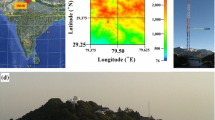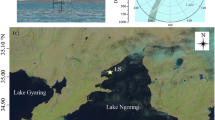Summary
¶Observational data collected in the Lake Tekapo hydro catchment of the Southern Alps in New Zealand are used to analyse the wind and temperature fields in the alpine lake basin during summertime fair weather conditions. Measurements from surface stations, pilot balloon and tethersonde soundings, Doppler sodar and an instrumented light aircraft provide evidence of multi-scale interacting wind systems, ranging from microscale slope winds to mesoscale coast-to-basin flows. Thermal forcing of the winds occurred due to differential heating as a consequence of orography and heterogeneous surface features, which is quantified by heat budget and pressure field analysis.
The daytime vertical temperature structure was characterised by distinct layering. Features of particular interest are the formation of thermal internal boundary layers due to the lake-land discontinuity and the development of elevated mixed layers. The latter were generated by advective heating from the basin and valley sidewalls by slope winds and by a superimposed valley wind blowing from the basin over Lake Tekapo and up the tributary Godley Valley.
Daytime heating in the basin and its tributary valleys caused the development of a strong horizontal temperature gradient between the basin atmosphere and that over the surrounding landscape, and hence the development of a mesoscale heat low over the basin. After noon, air from outside the basin started flowing over mountain saddles into the basin causing cooling in the lowest layers, whereas at ridge top height the horizontal air temperature gradient between inside and outside the basin continued to increase.
In the early evening, a more massive intrusion of cold air caused rapid cooling and a transition to a rather uniform slightly stable stratification up to about 2000 m agl. The onset time of this rapid cooling varied about 1–2 h between observation sites and was probably triggered by the decay of up-slope winds inside the basin, which previously countered the intrusion of air over the surrounding ridges. The intrusion of air from outside the basin continued until about mid-night, when a northerly mountain wind from the Godley Valley became dominant. The results illustrate the extreme complexity that can be caused by the operation of thermal forcing processes at a wide range of spatial scales.
Similar content being viewed by others
Author information
Authors and Affiliations
Additional information
Received June 25, 2001; Revised December 21, 2001
Rights and permissions
About this article
Cite this article
Kossmann, M., Sturman, A., Zawar-Reza, P. et al. Analysis of the wind field and heat budget in an alpine lake basin during summertime fair weather conditions. Meteorol. Atmos. Phys. 81, 27–52 (2002). https://doi.org/10.1007/s007030200029
Issue Date:
DOI: https://doi.org/10.1007/s007030200029




